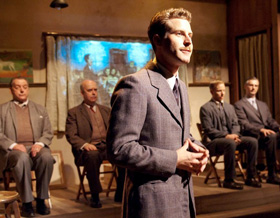
The Pitmen Painters recounts the fortunes of a group of English coal miners who hire a professor through their Workman's Education Association to teach a night-school course in Art Appreciation. When the teacher assigns his pupils the task of making their own art to serve as material for discussion. None of them anticipate a fashionable collector championing their amateur efforts to make them the toast of 1936 London.
In the big auditoriums where Lee Hall's play premiered on both sides of the Atlantic, audiences saw the contents of the muddy squares referenced onstage projected on huge screens—but Timeline Theatre's church-basement space seats its spectators less than 12 feet from the dramatic action, mandating physical pictures resembling those magnified hundreds of times. A few years ago, this task would entail copies of the slow-drying oils executed in quick-dry acrylics by a squad of SAIC students. In our technologically-advanced age, however, Property Designer Julia Eberhardt scoffs at such primitive methods of art-forgery.
The key to reproducing portraiture nowadays, she explains, lies in a process called wide-format print. But how wide? "To get a sense of the picture sizes, [scenic designer] Timothy Mann and I looked at video clips of the original London production. Once we had the dimensions, he started on the frames and I started scouring the internet for printable canvas."
Are there many different grades of this product? "Oh, yes. What we ended up using was a kind that had more of a muslin look. The print colors bled into each other a bit—but this made them look more like actual paintings, so it was to our advantage."
What else did you do to make the art look freshly-executed? "My original idea was to coat them with a clear gesso, but after we put them under the stage lights, some of them seemed awfully washed out. Our solution was to put a semi-gloss polyurethane on the ones that needed help. This worked so well, I wanted to make all of them glossy—but then they would all look the same, so only four of the nine in the play are covered in poly."
How about the unfinished painting in Professor Lyons' studio? "The sketches on the floor, I drew myself—they're supposed to be only studies, so they weren't hard. But the incomplete painting on the easel had to be photoshopped through a stylized filter and some of the figures removed to create the impression of being just roughed in. I made the palette backstage during a tech rehearsal, mixing the colors to match what was on the canvas and using hot-glue pools to give them dimension. Fortunately, some of the paints already had a shiny finish, so they looked like they were wet."
The script also calls for us to see Lyons drawing Oliver at one point? How did Andrew Carter [who plays Lyons] fake that? "I photoshopped the finished picture down to the basic outlines, traced very lightly. This way Andrew could fill it in during the scene."
Kind of like a coloring book? "Fortunately, Andrew is a very good artist! Seriously, though, the point the play makes is that art's meaning lies in the relationship between the art and the viewer. The whole process of making these props made me realize that it didn't matter how we did what we did, but how the audience saw it in the end."
The Pitmen Painters runs through December 4.
Mary Shen Barnidge
Contributing Writer

 Follow Us On Twitter
Follow Us On Twitter